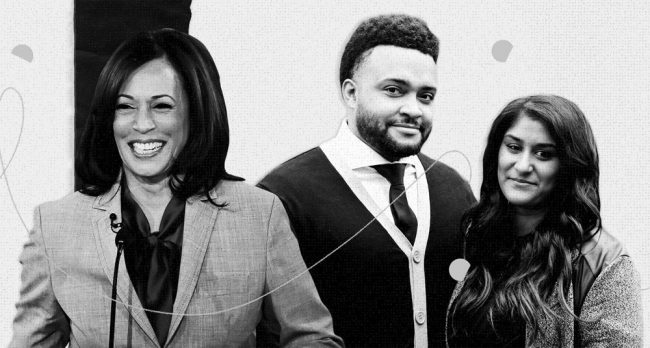Vice President-elect Kamala Harris Has Elevated the Blindian Community
 Washington DC: Sharda Sekaran was raised by a single Black mom. She went to mostly Black schools as a child, in mostly Black neighborhoods. Looking at her, she says, some people assume she’s Black.
Washington DC: Sharda Sekaran was raised by a single Black mom. She went to mostly Black schools as a child, in mostly Black neighborhoods. Looking at her, she says, some people assume she’s Black.
But her name — Sharda — always gave her away.
All her life, Sekaran has searched for other “Blindians” — people with one Black and one Indian parent. The closest she came was the couple in “Mississippi Masala,” she says, a 1991 movie about a Black man and an Indian woman who fall in love.
In 2010, she says, she heard about a woman running for attorney general in California. She looked Black. But her name gave her away.
Vice President-elect Kamala D. Harris will make history in a lot of different ways when she is inaugurated on Jan. 20. The daughter of an Indian mother and a Jamaican father, she will be the first Black vice president and the first Indian American vice president, as well as the first woman to hold elected office in the White House. Her racial identities are often discussed separately, heralded as a win for two different groups. But Harris also exists at a unique cultural intersection: Both Black and Indian, she will elevate a community that has struggled for acceptance in a country where few people share their background.
“It’s a validation of the identity I’ve had to fight for,” said Sekaran, who grew up in Michigan and New York and now lives in Denmark. When people asked about her name in school, she would lie: It was easier to say her parents were “hippies” with an interest in Sanskrit, she said, than explain that her father is Indian. “Now I can be unapologetic about having a unified identity — not walking away from the complexities it presents, but holding them close.”
The term “Blindian” was popularized by the Blindian Project, an Instagram account created in 2017 as a community for Black and South Asian couples and families. While many in the group are from India, people from other South Asian countries also identify with the term, said Jonah Batambuze, who founded the Blindian Project.
Black and South Asian couples face challenges different from those experienced by other mixed-race partners in the United States, often confronting anti-Black racism from family and the broader South Asian community, said Nitasha Sharma, a professor of Asian American studies and African American studies at Northwestern University, who is in a Blindian relationship herself. For many Indian parents who immigrate to the United States, a Black boyfriend is a “worst-nightmare” scenario, says Sharma. Unaccustomed to the American racism they experience, Sharma says, Indian immigrants may try to distinguish themselves from Black Americans as a way to re-create privilege they had back home.
Anjali Ferguson of Richmond, Va., dated her husband, who is Black, for six years before her parents agreed to meet him. They claimed their objections had nothing to do with race, she said, saying they couldn’t be racist because they were also people of color. Ferguson feels sure they would have responded differently if she had brought home a White man, she said: “Throughout my relationship, there has been continued racial biases and remarks. It’s a really deep-rooted anti-Blackness.”
While Harris has said little about her parents’ relationship, it’s hard to imagine they didn’t experience this kind of adversity, said Sharma, especially in the 1960s.
Harris clearly sees herself as a Black woman, Sharma said. While she often talks about her mother, she describes herself as part of the Black community in speeches and public statements, shaped by her time at Howard University, a historically Black college, and the sisters of Alpha Kappa Alpha, an all-Black sorority.
“[My mother] raised us to be proud, strong Black women and she raised us to know and be proud of our Indian heritage,” Harris said during her speech at the Democratic National Convention in August.
Many Americans didn’t realize that Harris is Indian until she was selected as the Democratic vice-presidential nominee, said Sharma, when more media outlets began to cover her Indian roots.
Sharma isn’t surprised that Harris “moves and identifies as a Black woman.” In the United States, she says, the “one-drop rule” persists. The concept originated during slavery: If you have “one drop” of Black heritage, you’re considered Black. When Harris highlights her Black identity, Sharma says, she’s not denying that she’s Indian. “She just operates in a nation where, if you are Black, you are Black only.”
For most of her childhood, Sekaran did what she could to assimilate into the Black community, shrugging off Indian Americans who would question her about her heritage. Her father left when she was a baby, she said, largely because his family didn’t accept her Black mother and their daughter.
“It was just easier to operate within a Black American identity,” she said. If she tried to assimilate into the Indian community, she said, she worried she’d face more rejection.
That changed in college, she said, when she was asked to join an Asian mentoring group. As she got to know more Indian Americans, she said, she gave herself permission to investigate this part of her heritage, treating it like a “mystery to uncover.” — Washington Post
